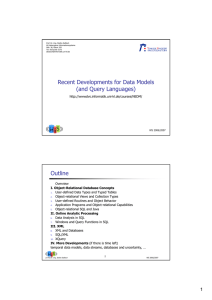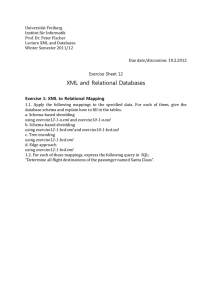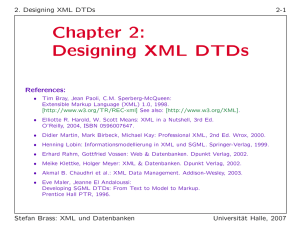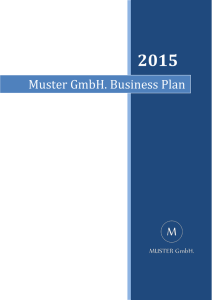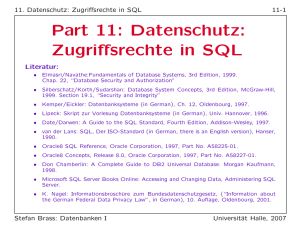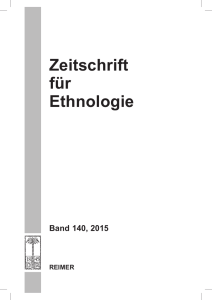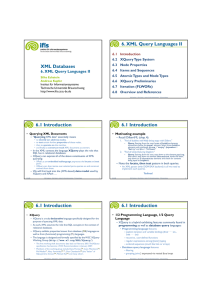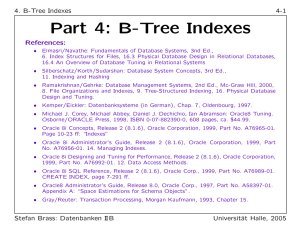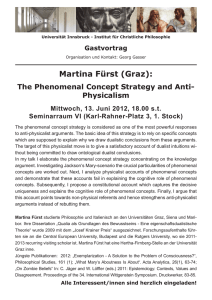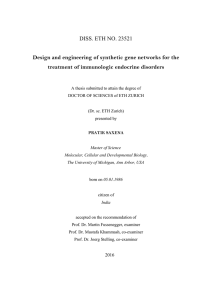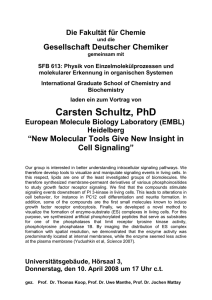Chapter 7: XQuery
Werbung
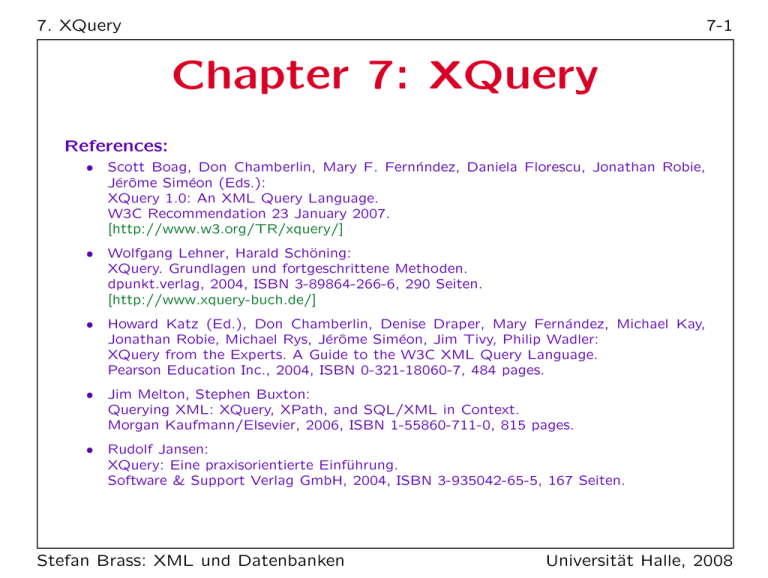
7. XQuery
7-1
Chapter 7: XQuery
References:
•
Scott Boag, Don Chamberlin, Mary F. Fernńndez, Daniela Florescu, Jonathan Robie,
Jérôme Siméon (Eds.):
XQuery 1.0: An XML Query Language.
W3C Recommendation 23 January 2007.
[http://www.w3.org/TR/xquery/]
•
Wolfgang Lehner, Harald Schöning:
XQuery. Grundlagen und fortgeschrittene Methoden.
dpunkt.verlag, 2004, ISBN 3-89864-266-6, 290 Seiten.
[http://www.xquery-buch.de/]
•
Howard Katz (Ed.), Don Chamberlin, Denise Draper, Mary Fernández, Michael Kay,
Jonathan Robie, Michael Rys, Jérôme Siméon, Jim Tivy, Philip Wadler:
XQuery from the Experts. A Guide to the W3C XML Query Language.
Pearson Education Inc., 2004, ISBN 0-321-18060-7, 484 pages.
•
Jim Melton, Stephen Buxton:
Querying XML: XQuery, XPath, and SQL/XML in Context.
Morgan Kaufmann/Elsevier, 2006, ISBN 1-55860-711-0, 815 pages.
•
Rudolf Jansen:
XQuery: Eine praxisorientierte Einführung.
Software & Support Verlag GmbH, 2004, ISBN 3-935042-65-5, 167 Seiten.
Stefan Brass: XML und Datenbanken
Universität Halle, 2008
7. XQuery
7-2
Objectives
After completing this chapter, you should be able to:
• read and understand queries in XQuery.
• write queries to XML data in XQuery.
• enumerate and explain the clauses of FLWOR expressions.
• explain the use of direct and computed constructors.
• compare XQuery with SQL.
Stefan Brass: XML und Datenbanken
Universität Halle, 2008
7. XQuery
7-3
Overview
$
'
1. Introduction
&
%
2. Basic Syntax, Constructors
3. FLOWR-Expressions
4. Examples, Comparison with SQL
5. Prolog, Functions
Stefan Brass: XML und Datenbanken
Universität Halle, 2008
7. XQuery
7-4
Introduction (1)
• One can view XML as a data model, and every data
model should have a query language.
• XPath permits to
select nodes in a given XML document, and to
compute values from the data in a document,
but it does not permit to generate new nodes.
• An XML query language should be able to produce
new XML documents as result.
I.e. to transform given XML documents into documents that are differently structured, contain only a subset of the data, or additional
derived data.
Stefan Brass: XML und Datenbanken
Universität Halle, 2008
7. XQuery
7-5
Introduction (2)
• Joins are very limited in XPath (semijoins) or can
be formulated only procedurally (with for-loops).
Note that many powerful constructs such as for-loops got into XPath
only in Version 2.0 during the development of XQuery. Although today, XPath is sufficient for quite a lot of queries, the original XPath
was much more restricted.
• One cannot sort in XPath.
Sometimes, although the result set can be determined by a simple
Path expression, one must use the more advanced FLWOR-expression
(an XQuery construct, see below) only for the purpose of sorting.
• Of course, a good XML query language must be at
least as powerful as SQL.
Stefan Brass: XML und Datenbanken
Universität Halle, 2008
7. XQuery
7-6
Introduction (3)
• The XML format is a common interface to a lot of
different data sources (documents, relational databases, object repositories).
The data might be physically stored as XML, or might be only viable
as XML via a middleware.
• An XML query language permits to combine data
from different sources.
This integrating function of an XML query language is natural and
important. While also SQL can be used in distributed databases, and
there exist relational interfaces to non-relational data, this is much
more vendor-dependent (and typically expensive).
Stefan Brass: XML und Datenbanken
Universität Halle, 2008
7. XQuery
7-7
History (1)
• In December 1998, the W3C organized a workshop
about query languages for XML.
[http://www.w3.org/TandS/QL/QL98/].
• There was a lot of research about query languages
for semi-structured data models and XML in particular (e.g., Lorel, XQL, XML-QL, YATL, Quilt).
See, e.g.: XML Query Langauges, Experiences and Exemplars.
[http://www.w3.org/1999/09/ql/docs/xquery.html]
• The XML Query Working Group started in 1999
the work on a W3C standard XML query language.
[http://www.w3.org/XML/Query]
Stefan Brass: XML und Datenbanken
Universität Halle, 2008
7. XQuery
7-8
History (2)
• XPath 1.0 and XSLT 1.0 became a W3C Recommendation in November 1999.
• While it seemed natural that XPath-like expressions
should be used also in XQuery, the XQuery committee had quite different ideas for the exact details
of syntax and semantics.
XPath 1.0 came from the document processing community, not from
the database community. But having two similar languages that differed in important details was obviously not good. This lead to difficult
negotiations and ultimately the development of XPath 2.0.
Stefan Brass: XML und Datenbanken
Universität Halle, 2008
7. XQuery
7-9
History (3)
• XML Schema became a W3C recommendation in
May 2001.
• Steps of the XQuery standardization:
First Working Draft: February 15, 2001.
Last Call Working Draft: November 12, 2003
The last call period ended on February 15, 2004. Several updates
were published afterwards.
W3C Candidate Recommendation: Nov. 3, 2005
Update: June 8, 2006
W3C Proposed Recommendation: Nov. 21, 2006
W3C Recommendation: January 23, 2007
Stefan Brass: XML und Datenbanken
Universität Halle, 2008
7. XQuery
7-10
History (4)
• The following eight documents were developed together:
XQuery 1.0
XQueryX 1.0: XML Syntax for XQuery 1.0
XPath 2.0
XSLT 2.0
XQuery 1.0/XPath 2.0 Data Model
XQuery 1.0/XPath 2.0 Formal Semantics
XQuery 1.0/XPath 2.0 Functions and Operators
XSLT 2.0/XQuery 1.0 Serialization
Stefan Brass: XML und Datenbanken
Universität Halle, 2008
7. XQuery
7-11
History (5)
• Related documents (Working Group Notes):
XML Query Use Cases
[http://www.w3.org/TR/xquery-use-cases/]
XML Query (XQuery) Requirements
[http://www.w3.org/TR/xquery-requirements/]
• Extensions (Candidate Rec. May/Aug. 2008):
XQuery and XPath Full Text 1.0
[http://www.w3.org/TR/xpath-full-text-10/]
XQuery Update Facility 1.0
[http://www.w3.org/TR/xquery-update-10/]
Stefan Brass: XML und Datenbanken
Universität Halle, 2008
7. XQuery
7-12
XQuery vs. XSLT
• The two languages have overlapping, but not identical goals.
• XSLT was developed by the document processing
community. Main use: rendering XML documents.
Although it can also be used for selecting and restructuring data.
• XQuery is a database language.
• Databases store very many / very large documents:
indexes and query optimization are important (the
data does not fit completely into main memory).
The data is also more regularly structured (in most cases).
Stefan Brass: XML und Datenbanken
Universität Halle, 2008
7. XQuery
7-13
XQuery Implementations (1)
• IPSI XQ
Written in Java. [http://sourceforge.net/projects/ipsi-xq]
[http://www.ipsi.fraunhofer.de/oasys/projects/ipsi-xq/]
• AltovaXML
The engine used in XMLSpy is free (contains validator: DTD/Schema,
XSLT 1.0/2.0, XQuery). [http://www.altova.com/altovaxml.html]
• Galax
Open source, from some authors/editors of the XQuery Specification.
[http://www.galaxquery.org/]
• eXist (open source native XML database)
[http://exist.sourceforge.net/]
Online demo: [http://demo.exist-db.org/sandbox/sandbox.xql]
Stefan Brass: XML und Datenbanken
Universität Halle, 2008
7. XQuery
7-14
XQuery Implementations (2)
• X-HIVE
Commercial XML-DBMS, Online demo evaluator.
[http://support.x-hive.com/xquery/] (select first any demo, then
“your own”). [http://support.x-hive.com/xquery/basicservlet?
demo=demo0&xquery=xquery&todo=showframes]
• Saxon (from Michael Kay)
M. Kay is editor of the XSLT 2.0 Spec. Basic version (without static
type checking and XQuery→Java compiler) is open source. Supports
XSLT 2.0, XPath 2.0, XQuery 1.0. [http://saxon.sourceforge.net/]
• Qizx/open (open source Java implementation)
In Java. Limited version is free. [http://www.axyana.com/qizxopen/]
Online demonstration:
[http://www.xmlmind.com:8080/xqdemo/xquery.html]
Stefan Brass: XML und Datenbanken
Universität Halle, 2008
7. XQuery
7-15
Example Document (1)
SID
101
102
103
104
STUDENTS
FIRST
LAST
EMAIL
Ann
Smith
···
Michael Jones (null)
Richard Turner
···
Maria
Brown
···
CAT ENO
H
1
H
2
M
1
EXERCISES
TOPIC
MAXPT
Rel. Algeb.
10
SQL
10
SQL
14
Stefan Brass: XML und Datenbanken
SID
101
101
101
102
102
102
103
103
RESULTS
CAT ENO POINTS
H
1
10
H
2
8
M
1
12
H
1
9
H
2
9
M
1
10
H
1
5
M
1
7
Universität Halle, 2008
7. XQuery
7-16
Example Document (2)
• Translation to XML with data values in elements:
<?xml version=’1.0’ encoding=’ISO-8859-1’?>
<GRADES-DB>
<STUDENTS>
<STUDENT>
<SID>101</SID>
<FIRST>Ann</FIRST>
<LAST>Smith</LAST>
</STUDENT>
...
</STUDENTS>
...
</GRADES-DB>
Stefan Brass: XML und Datenbanken
Universität Halle, 2008
7. XQuery
7-17
First Example (1)
• Print all results for Homework 1:
for $s in /GRADES-DB/STUDENTS/STUDENT,
$r in /GRADES-DB/RESULTS/RESULT
where $s/SID = $r/SID and
$r/CAT = ’H’ and
$r/ENO = 1
return <h1>{ $s/LAST, $r/POINTS }</h1>
• Result:
<h1><LAST>Smith</LAST><POINTS>10</POINTS></h1>
<h1><LAST>Jones</LAST><POINTS>9</POINTS></h1>
<h1><LAST>Turner</LAST><POINTS>5</POINTS></h1>
Stefan Brass: XML und Datenbanken
Universität Halle, 2008
7. XQuery
7-18
First Example (2)
• A characteristic feature of XQuery are “FLWORexpressions” (pronounced “Flower-expressions”).
• This name is derived from the keywords for, let,
where, order by, return.
They are written “FLWOR-expressions”, and pronounced “Flower”,
although two characters are exchanged: where comes before order by.
• The for-clause corresponds to FROM in SQL: It generates a sequence of variable bindings.
• The return-clause corresponds to SELECT in SQL: It
produces a piece of output for each variable binding
that satisfies the where-clause.
Stefan Brass: XML und Datenbanken
Universität Halle, 2008
7. XQuery
7-19
First Example (3)
• Note that the order of the clauses in XQuery fits
better with the evaluation sequence: Also in SQL,
FROM is conceptually evaluated first, and SELECT last.
• In XQuery, all keywords are written in lower case.
In contrast, SQL is case-insensitive. However, since case is important
in XML, the choice for XQuery seems natural. As XPath, XQuery has
no reserved words. It is possible to name an element for.
• XPath 2.0 is a subset of XQuery, i.e. FLWORexpressions are not the only type of queries.
The for-loop in XPath is a simplified version (special case) of the
FLWOR-expression in XQuery.
Stefan Brass: XML und Datenbanken
Universität Halle, 2008
7. XQuery
7-20
First Example (4)
• Expressions can be arbitrarily nested, also inside
explicitly given XML (direct element constructors).
• < starts literal XML mode, and {...} marks sections
that must be evaluated:
<result>{ for ... where ... return ... }</result>
• Result:
<result>
<h1><LAST>Smith</LAST><POINTS>10</POINTS></h1>
<h1><LAST>Jones</LAST><POINTS>9</POINTS></h1>
<h1><LAST>Turner</LAST><POINTS>5</POINTS></h1>
</result>
Stefan Brass: XML und Datenbanken
Universität Halle, 2008
7. XQuery
7-21
First Example (5)
• Of course, the value of an XQuery expression is an
XDM sequence.
• How this is printed (“serialized”) depends on the
implementation (most have options to control this).
• E.g., it could be written into one long line, or indented with one element per line:
<result>
<h1>
<LAST>Smith</LAST>
<POINTS>10</POINTS>
</h1>
...
</result>
Stefan Brass: XML und Datenbanken
Universität Halle, 2008
7. XQuery
7-22
Overview
1. Introduction
'
$
2. Basic Syntax, Constructors
&
%
3. FLOWR-Expressions
4. Examples, Comparison with SQL
5. Prolog, Functions
Stefan Brass: XML und Datenbanken
Universität Halle, 2008
7. XQuery
7-23
Overall Syntax (1)
• The basic XQuery unit is a module.
• A module can be
a library module (contains mainly function declarations),
a main module (contains mainly the query).
• Each module may optionally start with a version
declaration:
xquery version "1.0";
One can also specify the encoding, but the treatment of this is
implementation-dependent: xquery version "1.0" encoding "utf-8";
Stefan Brass: XML und Datenbanken
Universität Halle, 2008
7. XQuery
7-24
Overall Syntax (2)
• A main module consists of a prolog (which can be
empty) and the query (“QueryBody”).
• A library module consists of a module declaration
and a prolog.
• The prolog can contain
First an arbitrary sequence of namespace declaractions, module import commands (for schemas
and modules), and XQuery parameter settings,
and then an arbitrary sequence of variable, function, and option declarations.
Stefan Brass: XML und Datenbanken
Universität Halle, 2008
7. XQuery
7-25
Overall Syntax (3)
• The query itself (“QueryBody”) is an expression.
• XPath-expressions are also XQuery-expressions.
However, the grammar in the XQuery standard completely defines
expressions. Basically, XPath is a restricted version of XQuery. Since
XQuery has extensions in many places, it was not possible to simply
embedd an XPath expression as defined in the XPath standard.
• As in XPath, all data values are sequences of items,
where items are atomic values or nodes.
• Expressions can be arbitrarily nested.
While only recent SQL DBMS support the use of an SQL query with
one result value as a term, the arbitrary nesting was a basic design
principle in XQuery. It is sometimes called a funtional language.
Stefan Brass: XML und Datenbanken
Universität Halle, 2008
7. XQuery
7-26
Expressions (1)
• On the top level, an expression consists of one
or more subexpressions (“ExprSingle”) separated
by “,” (sequence concatenation operator).
• On the next level, an expression (“ExprSingle”) is
a FLWOR-expression,
a quantified expression (some, every)
a typeswitch expression (see below)
an if-expression,
or an expression with the usual logical, comparison and arithmetic operators (see below).
Stefan Brass: XML und Datenbanken
Universität Halle, 2008
7. XQuery
7-27
Expressions (2)
• In comparison, the XPath 2.0 grammar has
a for-expression instead of the FLWOR-expression,
no typeswitch expression.
• Note that the for-expressions in XPath 2.0 are valid
FLWOR-expressions in XQuery:
They have only the for and the return part.
It is legal in XQuery to leave out the other parts.
The for-clause is simplified: XQuery permits to
declare a type for the variable, and to add a positional variable (see below).
Stefan Brass: XML und Datenbanken
Universität Halle, 2008
7. XQuery
7-28
Expressions (3)
• The grammars for XQuery and XPath 2.0 are very
similar (they are generated from a single source,
only some possibilities are missing in XPath or replaced by simpler mechanisms).
• Continuing the comparison, one finds that
Quantified expressions (some, every) permit a type declaration for the variable in XQuery.
In XPath, no such type declaration is possible. In XQuery, it is
optional (thus, XPath is still a subset of XQuery).
Stefan Brass: XML und Datenbanken
Universität Halle, 2008
7. XQuery
7-29
Expressions (4)
• The “valueExpression” (Argument of unary + and
-, i.e. at the end of the operator hierarchy) is a
path expression in XPath. In XQuery, there are two
additional possibilities:
validate (strict|lax) { hExpressioni }
The expression must evaluate to exactly one document or element
node. It is treated as an XML infoset (i.e. existing type annotations are ignored), validated according to the “in-scope schema
definitions”, and a new tree is built from the PSVI. However, the
“Schema Import Feature” is optional in XQuery.
An “extension expression” with a pragma:
(# ...#) { hExpressioni }
Stefan Brass: XML und Datenbanken
Universität Halle, 2008
7. XQuery
7-30
Expressions (5)
• As explained above, the XPath grammar permits
the namespace axis, with is not supported in XQuery.
But because it can be supported only in an inefficient way, it is anyway
no longer recommended to use it.
• The next difference is in the “Primary Expression”:
Both languages permit numeric and string literals, variable references, expressions in (...), the
context item “.”, and function calls.
XQuery permits in addition constructors (see below), and “ordered|unordered { hExpressioni }”.
Stefan Brass: XML und Datenbanken
Universität Halle, 2008
7. XQuery
7-31
Operator Precedences (1)
Prio
1
2
3
4
5
6
7
8
9
10
Operator
, (comma)
:= (assignment)
for, some, every, typeswitch, if
or
and
eq,ne,lt,le,gt,ge,=,!=,<,<=,>,>=,is,<<,>>
to
+, *, div, idiv, mod
union, |
Assoc.
left
right
left
left
left
left
left
left
left
left
(continued on next slide)
Stefan Brass: XML und Datenbanken
Universität Halle, 2008
7. XQuery
7-32
Operator Precedences (2)
(continued from previous slide)
Prio
11
12
13
14
15
16
17
18
19
Operator
intersect, except
instance of
treat
castable
cast
- (unary), + (unary)
?, *, + (Occurrence Indicators)
/, //
[ ], ( ), {}
Assoc.
left
left
left
left
left
right
left
left
left
Only differences (additions) to XPath: :=, typeswitch.
Stefan Brass: XML und Datenbanken
Universität Halle, 2008
7. XQuery
7-33
typeswitch-Expression (1)
• The typeswitch-expression permits to check the dynamic type of an expression, and to distinguish different cases based on this type:
typeswitch($cust/address)
case $a as element(*,USAddr) return $a/state
case $a as element(*,CanAddr) return $a/prov
case
element(*,GermanAddr) return ()
default return fn:error("Unknown address type")
• element(*,USAddr) matches any non-nilled element
node with type annotation USAddr.
Or a type derived from that. This example needs schema validation.
Stefan Brass: XML und Datenbanken
Universität Halle, 2008
7. XQuery
7-34
typeswitch-Expression (2)
• The first case-clause with a matching type is selected, or the default clause if non matches.
• A variable must be declared in the case only if the
value of the original expression is needed to compute the return value.
The scope of this variable declaration is this single case. Different
cases can declare variables with the same name.
• The same effect can be achieved with conditional
expressions (if) and “instance of”.
“treat as” is necessary in addition to use the value as a value of its
real type. So in the end, the typeswitch simplifies the expression.
Stefan Brass: XML und Datenbanken
Universität Halle, 2008
7. XQuery
7-35
Constructors: Overview
• An important difference between XPath and XQuery is that XQuery can generate new nodes, XPath
can only select nodes from given documents.
• Creating new nodes is done by constructors.
• There are two types of constructors in XQuery:
Direct constructors, which look like XML text.
There e.g. the node name is explicitly given.
Computed constructors, which have a new syntax, and permit to compute e.g. the node name
by an expression.
Stefan Brass: XML und Datenbanken
Universität Halle, 2008
7. XQuery
7-36
Direct Constructors (1)
• A direct constructor looks like XML text that is
directly copied to the output, but one can embed
XQuery expressions to be evaluated in {...}.
• For example, the XQuery expression
<a b="Aufg.{1*1}">1+1={1+1}</a>
is evaluated to <a b="Aufg.1">1+1=2</a>.
• Direct constructors are parsed by XQuery, they are
not copied character by character to the output.
The internal XDM representation of the output is constructed, thus
e.g. information about extra whitespace/line breaks inside tags is lost.
Stefan Brass: XML und Datenbanken
Universität Halle, 2008
7. XQuery
7-37
Direct Constructors (2)
• If one needs curly braces “{” or “}” in the data,
one must double them: “{{” or “}}”.
Alternatively, one can use character references: &#x7b; and &#x7d;.
• Because the direct constructor only mimicks XML,
but is defined in the XQuery grammar, there is a
slight difference: When one encloses an attribute
value inside ", one can use "" to denote the character " inside the string.
Correspondingly, when one encloses it in ’, the apostrophe is written ’’. This is the XQuery/XPath convention, not the XML convention. There one must use an entity reference or a character reference.
Stefan Brass: XML und Datenbanken
Universität Halle, 2008
7. XQuery
7-38
Direct Constructors (3)
• Furthermore, entity references and character references are expanded, not copied to the output:
Only the predefined entities (&lt;, &gt;, &amp;,
&quot;, &apos;) can be used in entity references.
It might be that the output serialization uses these entity references again if the character itself would be invalid (e.g. &quot;
inside a "-delimited attribute value). But if it is not necessary to
use the entity reference, it will be printed in expanded form.
In the same way, character references are expanded (e.g., &#97; is replaced by “a”).
Again, the output must of course be valid XML, which might
require some form of escaping (entity / character references).
Stefan Brass: XML und Datenbanken
Universität Halle, 2008
7. XQuery
7-39
Direct Constructors (4)
• XQuery comments (: ... :) cannot be used in the
direct element constructor, neither in the tags nor
in the content (except of course inside {...}).
In the tags they are a syntax error, in the content they are considered as text data. Formally, comments can appear everywhere where
“ignorable whitespace” can appear. A few productions in the XQuery
grammar are marked with /* ws:explicit */. Inside these productions, the nonterminal S (known form the XML grammar) is used to
mark explicitly where whitespace is allowed. This nonterminal does not
match the XQuery comment. The productions for the direct element
constructor have this explicit whitespace. In this way they are made
more compatible with the real XML grammar, although I personally
do not see the advantage of forbidding comments inside tags.
Stefan Brass: XML und Datenbanken
Universität Halle, 2008
7. XQuery
7-40
Direct Constructors (5)
• Allowed occurrences of embedded XQuery expressions ({...}) inside direct element constructors:
The element name (element type) and the attribute names must be given explicitly (a QName),
and cannot be computed with {...}.
If one wants to compute these, one must use the computed element constructor (see below).
Embedded XQuery expressions ({...}) can be
used only inside the attribute value (inside "..."
or ’...’) and in the element content.
Stefan Brass: XML und Datenbanken
Universität Halle, 2008
7. XQuery
7-41
Direct Constructors (6)
• If {...} is used in an attribute value, the constructed attribute value is computed as follows:
The expressions inside {...} are evaluated and
atomization is applied to the result.
Thus, one gets a sequence of atomic values for
each {...}. These values are converted (with a
cast) to strings, and concatenated with a single
space between each pair.
At the beginning and the end of the sequence, no space is inserted,
thus the empty sequence gives the empty string.
Stefan Brass: XML und Datenbanken
Universität Halle, 2008
7. XQuery
7-42
Direct Constructors (7)
• Computation of attribute value, continued:
Then the explicitly given characters and the
strings resulting from each {...} are concatenated without adding spaces.
Example:
<a b="xy{ 1 to 3 }z{ 3, 4 }" />
is evaluated to <a b="xy1 2 3z3 4"/>.
If the attribute name is xml:id, the attribute value is treated specially (as an ID).
Stefan Brass: XML und Datenbanken
Universität Halle, 2008
7. XQuery
7-43
Direct Constructors (8)
• The content of a direct element constructor can
contain (between start tag and end tag):
Literal text (without the characters <, {, }, &),
entity references for the five predefined entities,
character references,
CDATA sections: <![CDATA[...]]>,
enclosed expressions: {...},
other direct constructors (for element, comment,
and processing instruction nodes).
Stefan Brass: XML und Datenbanken
Universität Halle, 2008
7. XQuery
7-44
Direct Constructors (9)
• Even variable references are not interpreted inside
the content (or attribute value) of a direct element
constructor: The “$”-sign is treated as literal text.
• For example
for $i in (1, 2, 3) return <a>$i</a>
gives
<a>$i</a>
<a>$i</a>
<a>$i</a>
• Inside the constructor, one must write {$i} to get
the value of the variable $i.
Stefan Brass: XML und Datenbanken
Universität Halle, 2008
7. XQuery
7-45
Direct Constructors (10)
• A sequence of whitespace characters (e.g. spaces,
line breaks) within the content of a direct element
constructor is considered “boundary whitespace” if
it is delimited on both sides by
the start or end of the content (i.e. the start tag
or end tag of the direct element constructor), or
and enclosed direct constructor (e.g. start and
end tags of direct element constructors), or
an enclosed expression {...}.
Space characters generated by character references, CDATA sections, or enclosed expressions do not count as whitespace here.
Stefan Brass: XML und Datenbanken
Universität Halle, 2008
7. XQuery
7-46
Direct Constructors (11)
• Boundary whitespace is
eliminated if the boundary whitespace policy in
the static context is “strip”,
and it is copied to content of the construced
element node if the boundary whitespace policy
is “preserve”.
• The boundary whitespace policy can be set with a
declaration in the prolog:
declare boundary-space preserve;
• The default is implementation-defined.
Stefan Brass: XML und Datenbanken
Universität Halle, 2008
7. XQuery
7-47
Direct Constructors (12)
• Exercise: How does this XQuery expression look like
without the boundary whitespace?
<a>
<b> xy </b>
<c> {"xy"} </c>
<d> &#x20; <!-- This is a space --> </d>
(: Be careful here! :)
</a>
• The example shows also a direct comment constructor.
One cannot use enclosed expressions {...} in a direct comment constructor. One must write the comment explicitly. But there is of course
also a computed comment constructor (see below).
Stefan Brass: XML und Datenbanken
Universität Halle, 2008
7. XQuery
7-48
Direct Constructors (13)
• The content of a direct element constructor is evaluated to a sequence of nodes as follows:
Each consecutive sequence of literal characters
(including characters from entity/character references and CDATA sections) evaluates to a
single text node.
Each nested direct constructor is evaluated, resulting in a new node.
The parent property of this new node is set to the element node
that is currently being constructed. The standard also explains
how the base-uri-property is set (see Section 3.7.1.3).
Stefan Brass: XML und Datenbanken
Universität Halle, 2008
7. XQuery
7-49
Direct Constructors (14)
• Evaluation of content of a direct element constructor, continued:
Each enclosed expression {...} is evaluated to a
sequence of items.
For each subsequence of adjacent atomic values,
a single text node is constructed, containing the
values converted to strings with a single space
inserted between each pair.
For each node in the sequence returned by {...},
a new copy is made of this node and the entire
subtree below it. (see details below).
Stefan Brass: XML und Datenbanken
Universität Halle, 2008
7. XQuery
7-50
Direct Constructors (15)
• Eval. of content of direct element constr., cont.:
A document node is replaced by its children.
Now there might be again adjacent text nodes,
which are merged into a single text node.
• It is permitted that the resulting sequence contains
attribute nodes, but only at the very beginning.
• These become attributes of the constructed element nodes (in addition to the attributes explicitly
specified in the direct element constructor), the remaining nodes become its children.
Stefan Brass: XML und Datenbanken
Universität Halle, 2008
7. XQuery
7-51
Direct Constructors (16)
• The construction and copying of nodes is influenced
by the construction mode, which can be:
strip: a new document is constructed without
the information generated only by the validation.
So the new node as well as the copied element nodes receive
the type xs:untyped, and copied attribute nodes are treated as
xs:untypedAtomic. Properties nilled, is-id, and is-idrefs are all
set to false (except for attribute nodes called xml:id). All typed
values stored in the original nodes are converted to strings.
preserve: information from schema-validation of
the original document is preserved.
The new node gets the type xs:anyType, but all copied nodes
retain their original type. Properties like nilled are copied.
Stefan Brass: XML und Datenbanken
Universität Halle, 2008
7. XQuery
7-52
Direct Constructors (17)
• Another parameter is the copy-namespaces mode.
It contains two components:
preserve means that the in-scope namespaces of
the original node are copied to its copy.
no-preserve: only namespaces used in the element name or its
attributes (i.e. the necessary namespaces) are copied. But if then
the typed value of the element or one of its attributes is of type
QName or NOTATION (“namespace sensitive”), an error occurs.
inherit means that in-scope namespaces from
the constructed node are inherited to its contents (the copied nodes).
Possibly overridden by namespaces copied from original node.
Stefan Brass: XML und Datenbanken
Universität Halle, 2008
7. XQuery
7-53
Direct Constructors (18)
• The following example shows that nodes are indeed
copied, getting a new identity:
let $x
let $y
let $z
return
:= <a/>
:= <b>{$x}</b>
:= $y/a
if($x is $z) then "yes" else "no"
• let is a clause of the FLWOR-expression that binds
a variable to the sequence on the right hand side.
• The result is "no": Although $z is <a/> constructed
from $x, it has a new identity.
Stefan Brass: XML und Datenbanken
Universität Halle, 2008
7. XQuery
7-54
Computed Constructors (1)
• A computed constructor starts with a keyword that
indicates the type of node to be constructed:
element, attribute, text, processing-instruction,
comment, document.
• For node types with a name (element, attribute,
PI), a name specification follows. This can be an
explicitly given QName or an enclosed expression
{...} (“name expression of the constructor”).
• Next, the content is defined by an expression in
{...} (“content expression”) (optional).
Stefan Brass: XML und Datenbanken
Universität Halle, 2008
7. XQuery
7-55
Computed Constructors (2)
• E.g. the XQuery expression
element STUDENT {
element SID { 101 }
element FIRST { "Ann" }
element LAST { "Smith" }
}
gives
<STUDENT>
<SID>101</SID>
<FIRST>Ann</FIRST>
<LAST>Smith</LAST>
</STUDENT>
Stefan Brass: XML und Datenbanken
Universität Halle, 2008
7. XQuery
7-56
Computed Constructors (3)
• One can also compute the element (type) name:
element { concat("S", "ID") } { 100+1 }
• Atomization is applied to the name expression.
afterwards it must be of type xs:QName, xs:string, or xs:untypedAtomic.
• Otherwise, the processing is done as for direct constructors.
Especially, if the result of evaluating the content expression of an
element constructor starts with attribute nodes, these are assigned to
the constructed element node.
• If the content expression is missing, the content is
empty.
Stefan Brass: XML und Datenbanken
Universität Halle, 2008
7. XQuery
7-57
Computed Constructors (4)
• For attribute, text, comment, and PI constructors,
atomization is applied to the result of evaluating
the content expression.
• The resulting atomic values are cast into strings
and concatenated with a single space inserted between each pair (empty sequence → empty string).
• For constructed attribute nodes the type annotation is xs:untypedAtomic.
• Constructed text nodes are automatically deleted
when their text is the empty string.
Stefan Brass: XML und Datenbanken
Universität Halle, 2008
7. XQuery
7-58
Overview
1. Introduction
2. Basic Syntax, Constructors
$
'
3. FLOWR-Expressions
&
%
4. Examples, Comparison with SQL
5. Prolog, Functions
Stefan Brass: XML und Datenbanken
Universität Halle, 2008
7. XQuery
7-59
FLWOR-Expressions (1)
• An important construct of XQuery are FLWORexpressions (pronounced “Flower-expressions”):
for $hvari in hExprSinglei, . . .
let $hvari := hExprSinglei, . . .
where hExprSinglei
[stable] order by hOrderSpecListi
return hExprSinglei
• One can use for and let multiple times in arbitrary
order. At least one of the two is required.
ExprSingle is an XQuery expression without the “,” outside (...).
• where and order by are optional.
Stefan Brass: XML und Datenbanken
Universität Halle, 2008
7. XQuery
7-60
FLWOR-Expressions (2)
• The expressions in the for and let clauses are evaluted to produce a sequence.
In case of the for clause, this is called the “binding sequence” for the
variable.
• The for-clause iterates over the elements of sequence, e.g.
for $i in (1, 2, 3) return <a>{$i}</a>
gives
<a>1</a>
<a>2</a>
<a>3</a>
Stefan Brass: XML und Datenbanken
Universität Halle, 2008
7. XQuery
7-61
FLWOR-Expressions (3)
• In contrast, the let-clause assigns the entire sequence to the variable, e.g.
let $i := (1, 2, 3) return <a>{$i}</a>
gives
<a>1 2 3</a>
Here the sequence of atomic values is mapped to a single text node
as explained above for the constructors. But e.g.
let $i := (<a/>, <b/>, <c/>) return <x>{$i}</x>
gives
<x><a/><b/><c/></x>.
In contrast, for gives
<x><a/></x><x><b/></x><x><c/></x>.
Stefan Brass: XML und Datenbanken
Universität Halle, 2008
7. XQuery
7-62
FLWOR-Expressions (4)
• Semantically, it makes no difference whether several variables are bound in a single for/let-clause, or
whether the keyword is repeated each time.
This is of course the same rule as for the for-expressions in XPath.
• For instance,
for $i in (’a’, ’b’), $j in (1, 2)
return element {$i} { $j }
is equivalent to:
for $i in (’a’, ’b’)
for $j in (1, 2)
return element {$i} { $j }
Stefan Brass: XML und Datenbanken
Universität Halle, 2008
7. XQuery
7-63
FLWOR-Expressions (5)
• Both of the above queries produce the following
result (if ordering mode is ordered, see below):
<a>1</a>
<a>2</a>
<b>1</a>
<b>2</a>
• This fits well with the nested for-loops: For each
value of the variable $i in the outer for loop (each
element name), the inner for loop (over $j) (the
element content) is repeated once.
Stefan Brass: XML und Datenbanken
Universität Halle, 2008
7. XQuery
7-64
FLWOR-Expressions (6)
• Together, the for and let clauses produce a sequence of variable assignments (mapping each variable to a value, i.e. an XDM sequence).
• The XQuery standard uses the word “tuple” instead of “variable assignment”.
I consider that unfortunate, because it makes the comparison with
SQL more difficult (where each variable is bound to a “tuple”). The
standard uses the word “variable binding” for the association between a single variable and its value. A “tuple” consists of “variable
bindings”. Of course, it is formally true, that a tuple is the generalization of pair, triple, and so on, and here several “variable bindings”
are combined (a tuple can also be seen as a mapping from names to
values, which fits here, too, but usually the names are column names).
Stefan Brass: XML und Datenbanken
Universität Halle, 2008
7. XQuery
7-65
FLWOR-Expressions (7)
• The sequence of variable assignments generated by
for/let is called “tuple stream” in the standard.
• There is a parameter called “ordering mode”, which
can be “ordered” or “unordered”.
This parameter is explained in detail on Slide 7-79 and following.
• If the ordering mode is ordered, XQuery guarantees that the tuple stream is in the sequence that
corresponds to the nested for-loops (see above).
• Then the document order of the original document
is retained in the output of the query.
Stefan Brass: XML und Datenbanken
Universität Halle, 2008
7. XQuery
7-66
FLWOR-Expressions (8)
• Next, the where-clause acts as a filter on the “tuple
stream” (sequence of variable assignments).
• For each variable assignment, the expression under where is evaluated, and its effective boolean value is determined.
• If it is false, the variable assignment is deleted from
the sequence.
I.e. the remaining sequence of variable assignments contains only those variable assignments for which the where-condition is true. The
variable assignments remain in the same relative order in which they
were generated by the for and let-clauses.
Stefan Brass: XML und Datenbanken
Universität Halle, 2008
7. XQuery
7-67
FLWOR-Expressions (9)
• Because the effective boolean value is automatically determined, one can easily check the existence
of a node:
for $s in //STUDENT
where //RESULT[SID=$s/SID and CAT=’H’]
return $s/LAST
(students who submitted at least one homework).
Remember that the effective boolean value of a sequence that starts
with a node is true, whereas the effective boolean value of the empty
sequence is false. Other possible cases are singleton sequences of
boolean type, of string type including anyURI and untypedAtomic (only
the empty string is considered false), and of numeric type (only NaN
and 0 are treated as false). In all other cases, a type error occurs.
Stefan Brass: XML und Datenbanken
Universität Halle, 2008
7. XQuery
7-68
FLWOR-Expressions (10)
• The where-clause is optional. As in SQL, it defaults
to “true” (no variable assignments are deleted).
• If an “order by” clause is specified, the remaining
sequence of variable assignments is then sorted.
The order by-clause is explained on Slide 7-84 and following.
• The last step is the return-clause (required): For
each variable assignment, the return-expression is
evaluated, and the resulting item sequences are
concatenated in the order given by the current sequence of variable assignments.
Stefan Brass: XML und Datenbanken
Universität Halle, 2008
7. XQuery
7-69
FLWOR-Expressions (11)
• The length of the result sequence can differ from
the number of variable assignments considered, because the return-expression can evaluate to a sequence of arbitrary length (0, 1, or more).
• In the following query, there is one variable assignment per SQL exercise (2), but the output sequence contains one entry per solution (6 = 3 + 3):
for $e in //EXERCISE[TOPIC=’SQL’]
return (//RESULT[CAT=$e/CAT and ENO=$e/ENO]
div $e/MAXPT) * 100
Stefan Brass: XML und Datenbanken
Universität Halle, 2008
7. XQuery
7-70
FLWOR-Expressions (12)
• All subexpressions of the FLWOR-expression are
“ExprSingle”, thus the operator “,” for sequence
concatenation can be used only inside (...).
• The entire FLWOR-expression has a higher priority
than the comma operator, thus
for $i in (1, 2, 3)
return <a> {$i} </a>, <b/>
is not a syntax error, but returns
<a>1</a>
<a>2</a>
<a>3</a>
<b/>
Stefan Brass: XML und Datenbanken
Universität Halle, 2008
7. XQuery
7-71
FLWOR-Expressions (13)
• If one uses constructors under return, all nodes are
new (entire subtrees are copied).
• If one uses only standard XPath-expressions (e.g.
variable names), no copying is done.
This also necessary for the compatibility with XPath, which has simple
for-loops and never constructs new nodes (only new sequences).
• For example, the following returns "yes":
let $x
let $y
let $z
return
:= (<a/>)
:= (for $x1 in $x return $x1)
:= (for $x2 in $x return $x2)
if($y is $z) then "yes" else "no"
Stefan Brass: XML und Datenbanken
Universität Halle, 2008
7. XQuery
7-72
for-Clause: Details (1)
• The scope of a variable declared with for or let
extends from the point just after the binding expression (which defines the values for the variable)
to the end of the FLWOR-expression.
• Thus, the variable can already be used in binding
expressions for other variables declared later in the
same for-clause:
for $s in //STUDENT, $r in //RESULT[SID=$s/SID]
return element solved {$s/LAST, $r/CAT, $r/ENO}
Stefan Brass: XML und Datenbanken
Universität Halle, 2008
7. XQuery
7-73
for-Clause: Details (2)
• This rule for the scope of variables fits with the
equivalence with nested for-loops.
• It differs from SQL: There the variable declarations
in the FROM-clause are conceptually done in parallel.
Thus, one cannot use a tuple variable in a subquery later in the same
FROM-clause. This gives the query optimizer more freedom to determine
the join order.
• It is legal (but bad style) to declare several variables with the same name in a FLWOR-expression:
Each new declaration shadows the previously declared variable for the rest of the FLWOR-expression.
Stefan Brass: XML und Datenbanken
Universität Halle, 2008
7. XQuery
7-74
for-Clause: Details (3)
• One can define a “positional variable” associated
with a variable declared in a for-clause, e.g.
for $s at $i in //STUDENT
return element STUD {
attribute ID {$i},
$s/concat(LAST, ", ", FIRST)
}
• $i contains the position of the current value for $s
in the binding sequence, i.e. the value of //STUDENT.
• Positions are counted from 1. The result of the
query is shown on the next slide.
Stefan Brass: XML und Datenbanken
Universität Halle, 2008
7. XQuery
7-75
for-Clause: Details (4)
• In the example, the positional variable is used to
generate new unique IDs for the students:
<STUD
<STUD
<STUD
<STUD
ID="1">Smith, Ann</STUD>
ID="2">Jones, Michael</STUD>
ID="3">Turner, Richard</STUD>
ID="4">Brown, Maria</STUD>
• Other applications of positional variables include:
First-n queries (see below).
Sampling: E.g. take only every 10-th student:
$i mod 10 = 1
Stefan Brass: XML und Datenbanken
Universität Halle, 2008
7. XQuery
7-76
for-Clause: Details (5)
• It is also possible to declare a type for the variable:
for $p as xs:decimal
in //RESULT[CAT=’H’ and ENO=1]/POINTS
return $p div 10
• As I understand the standard, this is a type assertion (like “treat as”), so it should give an error here
(an element node is not a decimal value).
Type assertions might be necessary to permit static type checking.
• AltovaXML complains only if it cannot convert the
value to the required type (treats it as type cast).
• Positional variables always have type xs:integer.
Stefan Brass: XML und Datenbanken
Universität Halle, 2008
7. XQuery
7-77
for-Clause: Details (6)
• The for-clause consists of a comma-separated list
of one or more variable declarations, each consisting of:
The name of the variable (starting with “$”),
optionally, a type declaration, consisting of the
keyword “as” and a sequence type,
In the for-clause, the occurrence indicators ?, +, * are not relevant
because the variable is bound to single sequence elements.
optionally, a positional variable declaration, consisting of the keyword “at” and a variable name,
the keyword “in”, and an “ExprSingle”.
Stefan Brass: XML und Datenbanken
Universität Halle, 2008
7. XQuery
7-78
let-Clause: Details
• The let-clause consists of a comma-separated list
of one or more variable declarations with a slightly
different syntax than under for (to emphasize that
the entire sequence is bound to the variable):
Name of the variable (starting with “$”),
optionally, a type declaration, consisting of the
keyword “as” and a sequence type,
the symbol “:=”, and an “ExprSingle”.
• Of course, positional variables make no sense in the
let-clause (and are therefore not permitted).
Stefan Brass: XML und Datenbanken
Universität Halle, 2008
7. XQuery
7-79
Ordering Mode (1)
• The ordering mode has an important influence on
the semantics of XQuery expressions:
If it is ordered, the sequence of variable assignments constructed by for/let is as above.
I.e. it corresponds to nested loops in the order or variable declarations, and respects the document order.
If it is unordered, the implementation has more
freedom for query optimization: Especially, the
sequence of variable assignments generated by
for and let is in an implementation-defined order
(unless the order by clause is used).
Stefan Brass: XML und Datenbanken
Universität Halle, 2008
7. XQuery
7-80
Ordering Mode (2)
• But the consequences of ordering mode unordered
are even more drastic, because
in XPath expressions, document order does not
have to be respected,
thus selecting specific positions becomes more
or less meaningless (nondeterministic).
E.g. /a/b[1] gives any b-child of a, not necessarily the first.
But /a/b[3] is non-empty only if there are at least three b-children.
Stefan Brass: XML und Datenbanken
Universität Halle, 2008
7. XQuery
7-81
Ordering Mode (3)
• Thus, ordering mode unordered is not only a question of the output sequence, but can modify also
the selected values.
Actually, that is not so astonishing, because the arbitrary nesting of
XQuery expressions means that as soon as one allows a different result
sequence in FLWOR-expressions, one could anyway get an entirely
different result for the entire query, not only a permutation. Everything
in XQuery is a sequence, and the exact order matters in many places.
• When one uses the XPath function unordered(...)
only at this single point an arbitrary permutation is
allowed (not everywhere inside as with the ordering
mode). E.g. positions inside remain meaningful.
Stefan Brass: XML und Datenbanken
Universität Halle, 2008
7. XQuery
7-82
Ordering Mode (4)
• The ordering mode is part of the static context and
be set in the prolog, e.g.
declare ordering ordered
and locally inside the query with the expressions
ordered {...}, and
I.e. for evaluating “...”, the ordering mode is set to “ordered”.
unordered {...}.
Note the difference to unordered(...), the XPath function.
• The default value is implementation-defined.
This seems unfortunate, because it immediately causes portability
problems: The ordering mode is important for nearly every query.
Stefan Brass: XML und Datenbanken
Universität Halle, 2008
7. XQuery
7-83
Ordering Mode (5)
• E.g. suppose that the homework results are stored
in the document in order of submission (i.e. new
entries are always appended at the end).
• If one wants to print all student names in the sequence in which they submitted Homework 1, this
can be done as follows:
ordered {
for $r in //RESULT, $s in //STUDENT
where $r/CAT = ’H’ and $r/ENO = 1
and $r/SID = $s/SID
return $s/LAST
}
Stefan Brass: XML und Datenbanken
Universität Halle, 2008
7. XQuery
7-84
order by Clause (1)
• With the order by clause, one can sort the tuple
stream (variable assignments) generated by for/let.
After passing the filter of the where-clause and before the returnclause is evaluated.
• This is done by defining one or more expressions,
the values of which are used for sorting, e.g.
for $s in //STUDENT, $r in //RESULT[SID=$s/SID]
where $r/CAT = ’H’ and $r/ENO = 1
order by $r/POINTS
return $s/LAST
Stefan Brass: XML und Datenbanken
Universität Halle, 2008
7. XQuery
7-85
order by Clause (2)
• More specifically, the expression(s) are evaluated
for each variable assignment, and atomization is
applied.
After that, each expression must return a sequence of length ≤ 1 (for
a given variable assignment), i.e. a single value or the empty sequence.
Otherwise (longer sequence) a type error occurs.
• Values of type untypedAtomic are treated as string.
• Then the values of each expression (for all variable
assignments) must be comparable: The comparison
is done with the operator gt of the least common
supertype that has such an operator.
Stefan Brass: XML und Datenbanken
Universität Halle, 2008
7. XQuery
7-86
order by Clause (3)
• Suppose that n expressions are used as sort criteria, and the values for variable assignment A are
(x1, . . . , xn), and for variable assignment B, the values are (y1, . . . , yn).
• Then A comes after B in the sort order if there is
i ∈ {1, . . . , n} such that
neiter xj > yi nor yj > xj for j = 1, . . . , i − 1, and
xi > yi.
I.e. the result of the first expression has highest priority, the second
expression decides the relative order of two variable assignments when
the values of the first expression are equal/uncomparable, and so on.
Stefan Brass: XML und Datenbanken
Universität Halle, 2008
7. XQuery
7-87
order by Clause (4)
• For each expression, one can specify ascending or
descending:
ascending is the default: The least value is listed
at the beginning, the greatest at the end.
descending selects the inverse order: The maximum value is listed first, and then successively
smaller values, until the minimum value.
• The abbreviations asc and desc known from SQL
are not supported in XQuery.
Stefan Brass: XML und Datenbanken
Universität Halle, 2008
7. XQuery
7-88
order by Clause (5)
• Another difference to SQL is that XQuery does
not require that the values used for sorting are also
printed.
However, modern SQL DBMS do not actually have this requirement.
• For each column, one can specify
empty greatest: The empty sequence is listed last
in ascending order (first in descending order).
And NaN comes immediately before the empty sequence in ascending order (immediately after it in descending order).
empty least: The empty sequence comes first in
ascending order, last in descending order.
Stefan Brass: XML und Datenbanken
Universität Halle, 2008
7. XQuery
7-89
order by Clause (6)
• Thus, the order by clause consists of a commaseparated list of one or more “order specs”, each
of which consists of
an “ExprSingle” (values used for sorting),
optionally, one of the keywords “ascending” or
“descending”,
optionally, one of the phrases “empty greatest”
or “empty least”,
optionally, the keyword “collation” and an URI
literal (this defines the sort order for strings).
Stefan Brass: XML und Datenbanken
Universität Halle, 2008
7. XQuery
7-90
order by Clause (7)
• Finally, instead of “order by”, one can also write
“stable order by”.
• This means that if the sort criteria give no decision,
the original order of the variable assignments must
be kept (derived from the document order and the
sequence/nesting of for-loops).
• Of course, if an order by clause is specified, this takes precedence over the ordering mode “unordered”.
Stefan Brass: XML und Datenbanken
Universität Halle, 2008
7. XQuery
7-91
Overview
1. Introduction
2. Basic Syntax, Constructors
3. FLOWR-Expressions
'
$
4. Examples, Comparison with SQL
&
%
5. Prolog, Functions
Stefan Brass: XML und Datenbanken
Universität Halle, 2008
7. XQuery
7-92
Example Document (9)
• Version 1 (data in elements, structured by relation):
<?xml version=’1.0’ encoding=’ISO-8859-1’?>
<GRADES-DB>
<STUDENTS>
<STUDENT>
<SID>101</SID>
<FIRST>Ann</FIRST>
<LAST>Smith</LAST>
</STUDENT>
...
</STUDENTS>
...
</GRADES-DB>
Stefan Brass: XML und Datenbanken
Universität Halle, 2008
7. XQuery
7-93
Restructuring the Data (1)
• Suppose we want to remove the elements for the
relations (like STUDENTS), and put the tuple elements
directly below GRADES-DB:
<GRADES-DB>{
for $e in /GRADES-DB/*/*
return $e
}</GRADES-DB>
• This gives
<GRADES-DB>
<STUDENT>
<SID>101</SID>
...
Stefan Brass: XML und Datenbanken
Universität Halle, 2008
7. XQuery
7-94
Restructuring the Data (2)
• The opposite transformation (grouping tuple elements by relation) is also possible:
<GRADES-DB>
<STUDENTS>{
for $s in /GRADES-DB/STUDENT
return $s
}</STUDENTS>
<EXERCISES>{
for $e in /GRADES-DB/EXERCISE
return $e
}</EXERCISES>
...
</GRADES-DB>
Stefan Brass: XML und Datenbanken
Universität Halle, 2008
7. XQuery
7-95
Restructuring the Data (3)
• Nesting results under students (data in attributes):
<GRADES-DB>{
for $s in //STUDENT
return element STUDENT {
for $d in $s/*
return attribute {name($d)} {data($d)},
for $r in //RESULT[SID=$s/SID]
return element RESULT {
for $a in $r/*
where name($a) ne "SID"
return attribute {name($a)} {data($a)}
}
},
...(: Copy/transform EXERCISE data :)
}</GRADES-DB>
Stefan Brass: XML und Datenbanken
Universität Halle, 2008
7. XQuery
7-96
Restructuring the Data (4)
• The output looks as follows:
<?xml version=’1.0’ encoding=’UTF-8’?>
<GRADES-DB>
<STUDENT SID=’101’ FIRST=’Ann’ LAST=’Smith’>
<RESULT CAT=’H’ ENO=’1’ POINTS=’10’/>
<RESULT CAT=’H’ ENO=’2’ POINTS=’8’/>
<RESULT CAT=’M’ ENO=’1’ POINTS=’12’/>
</STUDENT>
<STUDENT SID=’102’ FIRST=’Michael’ LAST=’Jones’>
...
</STUDENT>
...
</GRADES-DB>
Stefan Brass: XML und Datenbanken
Universität Halle, 2008
7. XQuery
7-97
Overview
1. Introduction
2. Basic Syntax, Constructors
3. FLOWR-Expressions
4. Examples, Comparison with SQL
'
$
5. Prolog, Functions
&
Stefan Brass: XML und Datenbanken
%
Universität Halle, 2008
7. XQuery
7-98
Namespaces
• Namespaces can be defined in the Prolog:
declare namespace Prefix = "URI";
declare default element namespace "URI";
declare default function namespace "URI";
• The following namespace prefixes are predeclared:
xml = http://www.w3.org/XML/1998/namespace
xs = http://www.w3.org/2001/XMLSchema
xsi = http://www.w3.org/2001/XMLSchema-instance
fn = http://www.w3.org/2005/xpath-functions
local =
http:// www.w3.org/2005/xquery-local-functions
Stefan Brass: XML und Datenbanken
Universität Halle, 2008
7. XQuery
7-99
User-Defined Functions (1)
• One can declare functions in the prolog of the main
module (i.e. before the query) and library modules.
• Functions must be in a namespace, but for functions declared in the main module XQuery defines
the namespace prefix local.
• A simple example is:
declare function local:inc($n as xs:integer)
as xs:integer
{ $n+1 };
local:inc(1) (: This is the query :)
Stefan Brass: XML und Datenbanken
Universität Halle, 2008
7. XQuery
7-100
User-Defined Functions (2)
• Thus, a function declaration consists of:
The keywords “declare function”,
the name of the function with namespace prefix,
a comma-separated list of parameter declarations in (...), each consisting of a variable and optionally the keyword “as” and a sequence-type,
optionally, a specification of the return type: the
keyword “as” and a sequence-type,
and body of the function: an expression in {...}
and finally a “;”.
Stefan Brass: XML und Datenbanken
Universität Halle, 2008
7. XQuery
7-101
User-Defined Functions (3)
• If the types are not specified, item()* is assumed
(the most general type).
• Instead of a function body, one can also specify the
keyword “external”.
It is implementation-dependent if an how functions written in some
other language (e.g., C) can be linked to the XQuery evaluator.
• Functions can be recursive.
And also mutually recursive. XQuery becomes in this way computationally complete, but then it cannot guarantee termination.
Stefan Brass: XML und Datenbanken
Universität Halle, 2008
